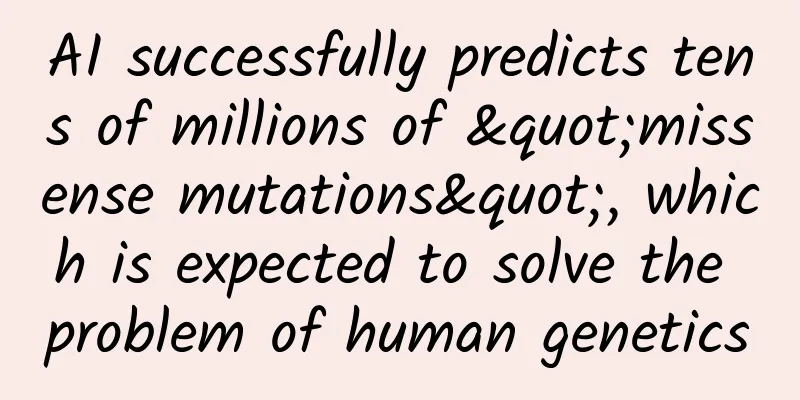AI successfully predicts tens of millions of "missense mutations", which is expected to solve the problem of human genetics

|
Artificial intelligence (AI) promises to solve one of the biggest challenges in human genetics. Just now, a research team from Google DeepMind created AlphaMissense based on the AlphaFold methodology - by utilizing the protein sequence database and variant structure background, it can identify pathogenic missense mutations and unknown pathogenic genes. It is reported that AlphaMissense shows superior capabilities compared to many existing similar tools (variant effect predictors or VEPs). Specifically, AlphaMissense successfully predicted the pathogenicity of 216 million possible single amino acid changes in 19,233 standard human proteins, and obtained predictions for 71 million missense mutations. Subsequently, AlphaMissense successfully predicted 89% of missense mutations, of which 57% may be benign and 32% may be pathogenic . The related research paper, titled “Accurate proteome-wide missense variant effect prediction with AlphaMissense”, has been published in the authoritative scientific journal Science. In a concurrent opinion piece, Joseph A. Marsh, Professor of Computational Protein Biology at the University of Edinburgh, and Sarah A. Teichmann, Head of Cell Genetics at the Wellcome Sanger Institute and Research Fellow at the University of Cambridge, commented: "While this research undoubtedly helps with variant interpretation and prioritization, it is important not to confuse these labels with the specific clinical definitions of these terms, which rely on multiple lines of evidence." It is worth mentioning that Google DeepMind has made all AlphaMissense predictions available to the research community for free and has open-sourced the code of the AlphaMissense model . Successfully predicted 89% of missense mutations Missense variants are genetic variants that can change the amino acid sequence of a protein . Pathogenic missense variants can severely disrupt protein function and reduce the fitness of an organism, while benign missense variants have limited effects. Of the more than 4 million observed missense variants, only approximately 2% have been clinically classified as pathogenic or benign, and classifying the remaining unknown variants is a major challenge in human genetics. The lack of accurate missense variant function prediction limits the diagnostic rate of rare diseases and the development and application of clinical treatments targeting the underlying genetic causes. Although multiplexed analysis of variant effects (MAVEs) systematically measure the effects of protein variants and can accurately predict the clinical outcome of variants, MAVEs experiments are costly and labor-intensive, and thus proteome-wide investigations of variant pathogenicity remain incomplete. Machine learning methods can close this variant interpretation gap by leveraging patterns in biological data to predict the pathogenicity of unannotated variants . The success of AlphaFold has demonstrated that it is possible to predict large-scale, high-precision protein structures using protein sequences as input, and such protein structure models can serve as the basis for understanding other aspects of protein biology, such as variant pathogenicity. In this study, AlphaMissense combined three elements of existing strategies with the help of AlphaFold’s methodology : 1) Weakly labeled training based on population frequency data avoids the use of manual annotations, thus avoiding circularity; 2) learning amino acid distributions conditioned on sequence context by using an unsupervised protein language modeling task; 3) Integrate context by using a system derived from AlphaFold. According to the paper, the training of AlphaMissense is divided into two stages : structural pre-training and variant fine-tuning. The pre-training stage is the same as described in AlphaFold, but with a higher weight added to the masked multiple sequence alignment reconstruction loss; during fine-tuning, the model is optimized to simultaneously predict the pathogenicity of the variant and the structure of the reference sequence. Previous studies have shown that benign training variants are based on variants frequently observed in humans and other primate species, which are defined according to the PrimateAI method, while pathogenic training variants are sampled from variants that have never been observed in the human population, with sampling weights depending on the trinucleotide context and gene. AlphaMissense does not predict the effect of a mutation on protein structure or other effects on protein stability. Instead, it uses a database of related protein sequences and the structural context of the variant to generate a score between 0 and 1 that assesses the probability that the variant is pathogenic . The continuous score allows the user to select a threshold that meets their accuracy requirements for classifying a variant as pathogenic or benign. AlphaMissense classified 89% of the 71 million possible missense variants as likely pathogenic or likely benign, compared to only 0.1% of variants that had been confirmed by human experts. AlphaMissense achieves state-of-the-art predictions on a wide range of genetic and experimental benchmarks, without being explicitly trained on such data. The model also outperformed other computational methods when used to classify variants in ClinVar, a public data archive on the relationship between human variation and disease. Potential solution to human genetics puzzle There is no doubt that AlphaMissense's predictions elucidate the molecular impact of variants on protein function, which helps identify pathogenic missense mutations and unknown pathogenic genes, while improving the diagnosis rate of rare genetic diseases. In addition, AlphaMissense will also promote the further development of specialized protein variant effect predictors. Marsh and Teichmann also pointed out a limitation of AlphaMissense : The structural component of its predictor currently does not take into account that most proteins assemble into complexes or condensates with diverse tetrameric structures. Mutations in proteins that form complexes may cause disease in ways that may not be obvious when considering only the monomeric structure. Furthermore, while many disease-associated mutations cause loss of function through protein instability or disruption of complex assembly, in other cases the mutant protein causes disease through dominant-negative or synergistic effects. It is therefore interesting to observe how AlphaMissense performs on non-loss-of-function variants, which are typically small perturbations to the amino acid and which almost all previously tested variant effect predictors (VEPs) have difficulty accurately predicting. Ultimately, incorporating information about protein tetramer structures may be possible through algorithms that predict protein complex structures, which is expected to lead to greater improvements in the field of variant effect prediction. Reference Links: www.science.org/doi/10.1126/science.adg7492 www.science.org/doi/10.1126/science.adj8672 Author: Yan Yimi Editor: Academic |
>>: "Pink Killer" wanted poster, AI's ability to read breast X-rays is comparable to that of doctors
Recommend
Meizu MX4 Flyme 4.5 beta version is available for use
After the release of Google Android 5.0, major mo...
WeChat reading product operation analysis!
Coinciding with World Book Day, this article prov...
Before launch, their engines must come here for a "test"!
The Beijing Institute of Spacecraft Testing and T...
How come “big fat meat” and “little maggots” grow in vinegar?
Vinegar, as a common condiment, is often used in ...
[Popular Science of Chinese Military Technology] How difficult is it to build a modern warship with stealth capabilities?
With the development of modern detection equipmen...
What are numbers? How do our brains perceive numbers?
A philosophical question has gradually evolved in...
Shanghai Auto Show opens tomorrow with 113 new cars making their global debut
The 17th Shanghai International Auto Show will op...
The difference between iQiyi splash screen ads and information flow ads
Often, advertisers will ask, iQiyi has so many ad...
Xbox One S: A new look, but the same substance - what's Microsoft trying to do?
Since Microsoft released Xbox One and Sony releas...
How to promote products overseas on TikTok?
In the past few years, the advertising market see...
Heytea’s private domain operation method
A few days ago, when I was browsing the news, I f...
When tasting tea in Changsha, you must find a reliable high-end tea selection place and let the experienced driver take you there
When tasting tea in Changsha, you must find a rel...
Xpeng Motors: Survey shows that Xpeng X9 BBA users account for 80% of households with an income of one million yuan and 33% of households
Xiaopeng Motors released a user profile of its el...
Night Parade of One Hundred Demons丨What kind of ghost will a person become after he dies?
Qingming Festival is one of the 24 solar terms an...
The first typhoon red alert this year! Super Typhoon Gemi is about to land, how to prepare for it?
Typhoon "Gemi" has been upgraded to the...









